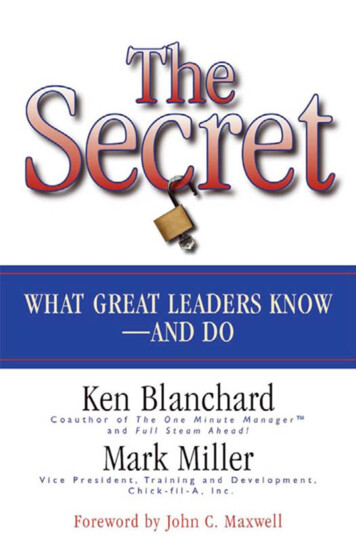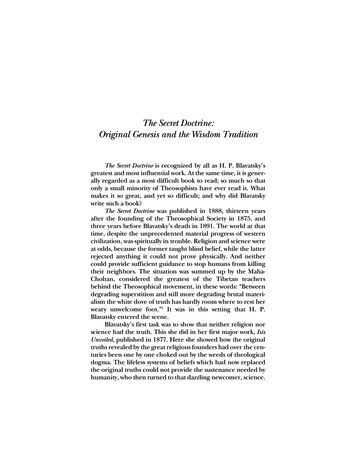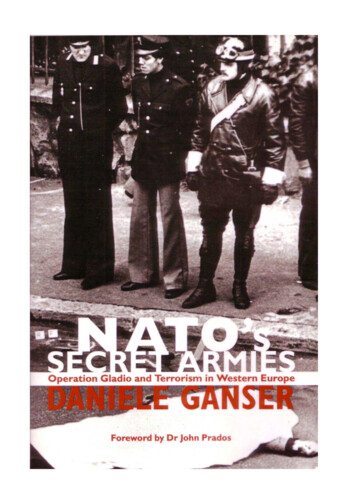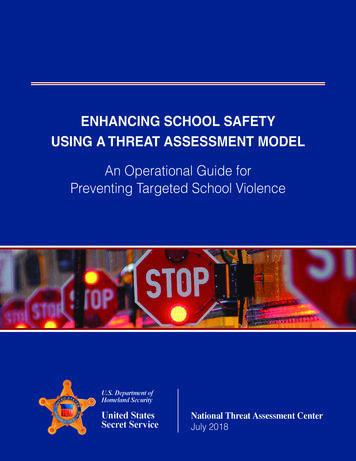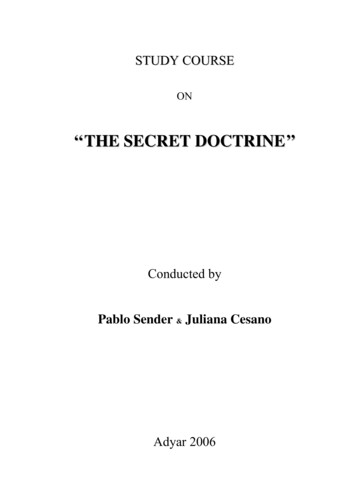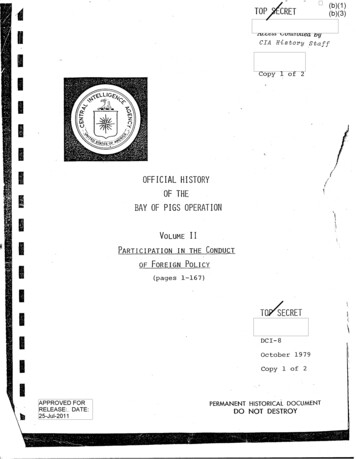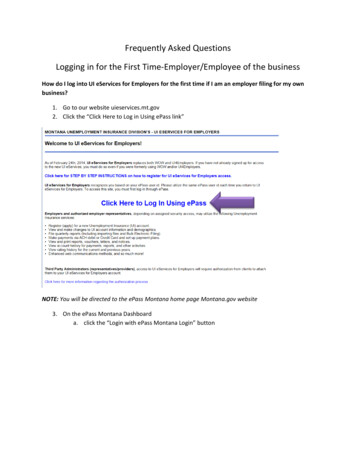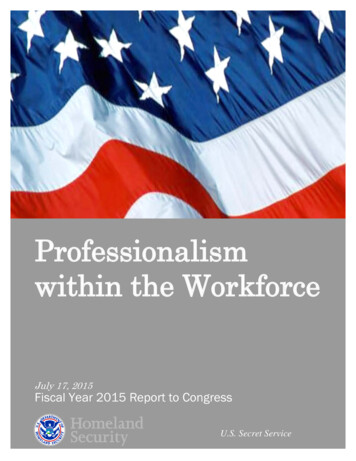
Transcription
Professionalismwithin the WorkforceJuly 17, 2015Fiscal Year 2015 Report to CongressU.S. Secret Service
Message from the Director of the U.S. Secret ServiceJuly 17, 2015I am pleased to present the following report,“Professionalism within the Workforce,” which has beenprepared by the U.S. Secret Service (Secret Service).This document has been compiled pursuant to a requirementin the Fiscal Year (FY) 2015 Department of HomelandSecurity (DHS) Appropriations Act (P.L. 114-4),accompanying Explanatory Statement, and HouseReport 113-481. Over the past 150 years, the Secret Servicehas established itself as one of the most highly regarded lawenforcement agencies in the world. The cornerstone of oursuccess has always been the selfless dedication to dutydisplayed by the men and women of this agency. This report outlines the actions theSecret Service has taken over the past several years to support that dedication and tocommunicate an unwavering organizational commitment to professionalism within theworkforce.Pursuant to congressional guidelines, this report is being provided to the followingMembers of Congress:The Honorable John R. CarterChairman, House Appropriations Subcommittee on Homeland SecurityThe Honorable Lucille Roybal-AllardRanking Member, House Appropriations Subcommittee on Homeland SecurityThe Honorable John HoevenChairman, Senate Appropriations Subcommittee on Homeland SecurityThe Honorable Jeanne ShaheenRanking Member, Senate Appropriations Subcommittee on Homeland Securityi
Executive SummaryThe mission of the Secret Service contributes significantly to DHS’s overarching goals ofpreventing terrorism and enhancing security, as well as safeguarding cyberspace andcritical infrastructure. The protection of the President and Vice President, in particular, iscentral to the continuity of government and DHS’s goal of reducing risk to the Nation’scritical infrastructure, key leadership, and events.To accomplish its mission, the Secret Service relies heavily on an exceptional workforcecomprising special agents, Uniformed Division officers, and administrative, professional,and technical support staff. As with all organizations, the Secret Service is judged by theactions of our workforce. To that end, Secret Service employees are not only responsiblefor carrying out the mission of the organization, but also for carrying out that mission in away that earns the trust and confidence of those we serve.While professionalism is the responsibility of all employees, the Secret Service as anorganization is responsible for providing the policies and mechanisms to reinforce it.Employee misconduct in Cartagena, Colombia, in April 2012, raised questions regardingwhether the Secret Service was doing everything it could do to carry out its responsibilityto support its employees and their professional development. To answer those questions,the Secret Service requested the assistance of the Professionalism ReinforcementWorking Group (PRWG), which was established approximately 1 month following theincidents that occurred in Cartagena. This working group was co-chaired by formerDirector John Berry of the Office of Personnel Management and Director Connie Patrickof the Federal Law Enforcement Training Center. Over the course of 8 months, they,along with a number of subject matter experts, conducted a comprehensive and objectivereview of Secret Service human resource policies and procedures. At the conclusion ofthis review, the PRWG issued 17 recommendations, which the Secret Service accepted.The two major recommendations made by the PRWG relating to discipline were(1) instituting a table of penalties that would instill greater transparency, consistency, andfairness to disciplinary processes; and (2) creating a standalone Office of Integrity (ITG).In November 2013, the Secret Service published the Table of Offense Codes and PenaltyGuidelines (Table of Penalties) 1 and applied it to all future disciplinary proceedings. TheTable of Penalties serves as a guide in determining appropriate corrective, disciplinary, oradverse actions for common offenses. The Secret Service established ITG 2 onDecember 1, 2013, which reports to the Deputy Director. ITG oversees adherence to theSecret Service’s code of conduct by impartially adjudicating allegations of employeemisconduct in a fair, consistent, and timely manner. The Chief Integrity Officer and the12See Appendix A.See Appendix B.iii
Deputy Chief Integrity Officer apply the guidance contained in the Table of Penalties toadjudicate substantiated allegations of employee misconduct.Another recommendation made by the PRWG was to develop and issue a user-friendlyEthics Desk Reference Guide to all Secret Service employees. This guide, which wasposted electronically on the agency’s Intranet in January 2013, and distributed to everyemployee in March 2013, highlights the Secret Service’s core values, complianceprinciples, standards of conduct, security clearance adjudication guidelines, and theexpectation that all employees must adhere to standards of ethical conduct.Although the fulfillment of these recommendations has strengthened professionalismwithin the agency, the Secret Service has continued its efforts to enhance, define, andcommunicate its expectations regarding professionalism and conduct to the workforce.Updating and revising policies as needed, the agency has kept a close eye on trendingissues affecting employee conduct. To that end, effective March 23, 2015, the SecretService issued a new policy prohibiting employees from operating a government-owned,-leased, or -rented vehicle within 10 hours of consuming an alcoholic beverage. On thatsame date, Deputy Director Magaw issued an official message to all Secret Serviceemployees emphasizing that any employee who violates this policy will be subject to thefull range of available disciplinary and adverse actions up to and including removal fromemployment. In addition, Director Clancy issued an official message to the entire SecretService workforce making clear that employees are required to report through their chainof command any activities that violate the agency’s standards of conduct or thatotherwise negatively affect the agency’s mission. Going forward, the Secret Service willcontinue to refine its policies in an effort to make clear the high standards that it sets forits employees.iv
Professionalism within the WorkforceTable of ContentsI.Legislative Language . 1II.Background . 3III. Review of Standards of Conduct and Establishment of a Professional StandardsPolicy. 4IV. New Guidance for the Procedures and Conduct of Employees When Engaged inOverseas Operations and Protective Missions .Other Relevant Training .In-Service Instructor-Led Ethics Courses .Instructor-Led Standards of Conduct (Ethics)—Supplement to In-ServiceTraining .On-Line Ethics Courses .1011121213VI. Conclusion. 15VII. Appendices . 17Appendix A: United States Secret Service Table of Penalties . 18Appendix B: Official Message and Manual Section Establishing the Office ofIntegrity . 53v
I.Legislative LanguageThis document has been compiled in response to language in the Fiscal Year (FY) 2015Department of Homeland Security (DHS) Appropriations Act (P.L. No. 114-4),accompanying Explanatory Statement, and House Report 113-481.P.L. 114-4 includes the following requirement: Provided further, That not later than 90 days after the date of enactmentof this Act, the Director of the United States Secret Service shall submit tothe Committees on Appropriations of the Senate and the House ofRepresentatives, a report providing evidence that the United States SecretService has sufficiently reviewed its professional standards of conduct; andhas issued new guidance and procedures for the conduct of employeeswhen engaged in overseas operations and protective missions, consistentwith the critical missions of, and the unique position of public trustoccupied by, the United States Secret Service: Provided further, That of thefunds provided under this heading, 10,000,000 shall be withheld fromobligation for Headquarters, Management and Administration until suchreport is submitted Additionally, the Explanatory Statement that accompanies P.L. 114-4 provides:Professionalism within the WorkforceAs described in the House report, recurring allegations ofmisconduct within the Secret Service are deeply disappointing. The SecretService is expected to take all steps necessary to ensure that it has in placethe proper training and protocols to prevent similar incidents and to holdviolators accountable for their actions. Accordingly, the bill withholds 10,000,000 from obligation for Headquarters, Management andAdministration until the Secret Service submits to the Committees, not laterthan 90 days after the date of enactment of this Act, a report providingevidence that the Secret Service has sufficiently reviewed its professionalstandards of conduct; issued new guidance for the procedures and conductof employees when engaged in overseas operations and protectivemissions; and instituted a professional standards policy consistent with theagency's critical missions and unique position of public trust.House Report 113-481 states:the bill withholds 20,000,000 from obligation for Headquarters,Management and Administration until the Secret Service submits to the1
Committee, not later than 90 days after the date of enactment of this Act, areport providing evidence that the Secret Service has sufficiently reviewedits professional standards of conduct; issued new guidance for theprocedures and conduct of employees when engaged in overseas operationsand protective missions; and instituted a zero-tolerance policy consistentwith the agency’s critical missions and unique position of public trust.2
II. BackgroundPursuant to Title 18 of the United States Code, sections 3056 and 3056A, the mission ofthe United States Secret Service (Secret Service or USSS) is to ensure the security of thePresident, the Vice President, their families, the White House Complex, the VicePresident’s residence, visiting world leaders, former Presidents and their spouses, andevents of national significance. The Secret Service also protects the integrity of ourcurrency and investigates crimes against our national financial systems committed bycriminals around the world and in cyberspace.To accomplish its mission, the Secret Service implements the following operationalprograms: protection; protective intelligence; and criminal investigations. The SecretService achieves excellence in these programs by developing leading-edge technologiesto mitigate emerging threats and contributing to the success of the goals DHS hasidentified in its Quadrennial Homeland Security Review.The Secret Service takes allegations of employee misconduct seriously. Any employee,regardless of rank or position, who engages in misconduct, will be held accountable forhis or her actions. This includes employees failing to report an incident, supervisorsinappropriately choosing not to act on information reported to them, or any acts taken orthreats of retaliation against an employee who reports misconduct.Approximately 1 month after the misconduct by Secret Service employees in Cartagena,Colombia, in April 2012, the Secret Service established a Professionalism ReinforcementWorking Group (PRWG). The PRWG, co-chaired by former Director John Berry of theOffice of Personnel Management (OPM) and Director Connie Patrick of the Federal LawEnforcement Training Center (FLETC), consisted of a panel of five governmentexecutives, supported by approximately 70 subject matter experts from OPM, FLETC,the Federal Bureau of Investigation (FBI), the U.S. military, and the Secret Service. ThePRWG was tasked with three major responsibilities: 1) review the Secret Servicecontrols on professional conduct; 2) benchmark the Secret Service against other similaragency best practices; and 3) identify any areas where the Secret Service excelled andareas where there is a need for enhancement.At the conclusion of its review, the PRWG issued 17 recommendations, all of which wereaccepted by the Secret Service. Additionally, the Secret Service has continued to updateand more fully implement its professionalism standards, including the institution of newreporting standards when employees encounter misconduct, disciplinary penalties forfailure to report misconduct, and new policies governing other specific facets ofemployee behavior.3
III. Review of Standards of Conduct and Establishmentof a Professional Standards PolicyIn May 2012, the Secret Service established the PRWG co-chaired by former OPMDirector John Berry and FLETC Director Connie Patrick who worked closely with apanel that consisted of more than 70 subject matter experts from OMB, FLETC, the FBI,members of the U.S. military, and the Secret Service. The PRWG was tasked with threemajor responsibilities: (1) review the Secret Service’s internal controls on professionalconduct; (2) benchmark the Secret Service against other federal agency’s best practices;and (3) identify any areas where the Secret Service excelled and where the agency neededto improve.Following an 8-month review, the PRWG found that, although a number of the SecretService’s procedures were identified as best practices, and many more were found to beconsistent with peer organizations, there were areas where enhancements could beimplemented to support the workforce further. The PRWG issued 17 recommendationswith the goal of reinforcing professionalism within the workforce. The Secret Serviceaccepted all of the recommendations, many of which were implemented by the end of2013, and, in accordance with a strategic action plan, all 17 were fully adopted by the endof 2014.As the PRWG was winding up its actions, the DHS Office of the Inspector General (OIG)began an audit and issued a report aimed at assessing the Secret Service’s “Efforts toIdentify, Mitigate, and Address Instances of Misconduct and Inappropriate Behavior.” 3In its report issued December 19, 2013, the DHS OIG “did not find evidence thatmisconduct is widespread in [the Secret Service].” 4 However, the report contained anumber of recommendations for the agency. Many of these recommendations concernedmatters that overlapped with the recommendations of the PRWG; some of which hadalready been fully implemented by the Secret Service. Nonetheless, by mid-April 2014,all recommendations issued by the DHS OIG had been completed and the recommendedprocedural changes fully established.Several of the recommendations made by the PRWG and the OIG focused onestablishing a robust disciplinary process grounded in transparency, consistency, andfairness. To meet these objectives, enhanced training and educational materialsemphasizing the expectation of ethical behavior and conduct were made available to allemployees. The Secret Service introduced updated training on ethics and standards of3Department of Homeland Security Office of Inspector General, Adequacy of USSS Efforts To Identify, Mitigate,and Address Instances of Misconduct and Inappropriate Behavior, December 2013. Available at:https://www.oig.dhs.gov/assets/Mgmt/2014/OIG 14-20 Dec13.pdf4Id. at 1.4
conduct; developed new briefings on professionalism that are given prior to majorprotective events and all overseas protective trips; and issued a user-friendly Ethics DeskReference Guide for all employees. The ethics guide, published in January 2013,highlights the Secret Service’s core values, compliance principles, standards of conduct,security clearance adjudication guidelines, and the expectation that all employees mustadhere to standards of ethical conduct.The two major recommendations made by the PRWG relating to discipline were (1) theinstitution of a table of penalties (the Table of Offense Codes and Penalty Guidelines, orTable of Penalties 5) that would ensure that employees knew the consequences for specificoffenses, instilling greater predictability and a sense of fairness to the disciplinaryprocess; and (2) the creation of a separate Office of Integrity.The development of the Table of Penalties began with the establishment of a SecretService working group that consisted of representatives from multiple offices in theagency, including the Office of Chief Counsel, the Office of Protective Operations, theOffice of Investigations, the Office of Technical Development and Mission Support, theOffice of Strategic Intelligence and Information, the Office of Administration, theSecurity Clearance Division, and the Human Capital Division/Employee RelationsBranch. Over a 6-month period, this working group benchmarked the Secret Serviceagainst other federal agencies, such as the FBI, U.S. Immigration and CustomsEnforcement, U.S. Customs and Border Protection, and the Transportation SecurityAdministration, and developed recommendations to centralize disciplinary processes anddevelop a table of penalties. A second working group comprising Deputy AssistantDirectors from each Secret Service directorate finalized the creation of an Office ofIntegrity and the Table of Penalties.In November 2013, the Secret Service published the Table of Penalties and applied it toall future disciplinary proceedings. The Table of Penalties is intended to serve as a guidein determining appropriate corrective, disciplinary, or adverse actions for commonoffenses. The purpose of the Table of Penalties is to: provide employees the ability to review both offenses and penalties for varioustypes of misconduct; provide consistency and predictability based on the facts of the incident; and provide penalties that are not overly narrow for a particular offense that may limitthe ability to take appropriate factors into consideration.In addition and in order to better facilitate consistent discipline, the Secret Serviceestablished the Office of Integrity (ITG) on December 1, 2013, as a separate office thatreports to the Deputy Director. On January 31, 2014, the functional responsibilities of5See Appendix A.5
the ITG were formalized and an organization chart was approved by the Chief IntegrityOfficer as follows:The ITG oversees adherence to the Secret Service’s code of conduct by impartiallyadjudicating allegations of employee misconduct in a fair, consistent, and timely manner.The Chief Integrity Officer and the Deputy Chief Integrity Officer apply the guidancecontained in the Table of Penalties to adjudicate substantiated allegations of employeemisconduct.With the ITG now firmly established and the Table of Penalties in use, the process forreporting and investigating allegations of misconduct, as well as proposing and takingdisciplinary action is more clearly defined than it was prior to April 2012. Under the newprocess, if an initial complaint is received by a front-line supervisor, the supervisor isrequired, outside of a limited number of minor violations, to report the allegation throughhis/her chain of command to the Secret Service Office of Professional Responsibility(RES). Within RES, the Inspection Division (ISP) then has a responsibility to chair anIntake Group meeting to review the misconduct allegations. The Intake Group comprisesthe Special Agent in Charge of ISP, the Chief of the Security Clearance Division orhigher, the Deputy Chief Integrity Officer, an attorney from the Office of Chief Counsel,and a representative from the Assistant Director’s office where the affected employee isassigned.The Intake Group has a responsibility to examine the allegation to (1) determine whetherfurther investigation by ISP is warranted, (2) refer allegations of misconduct whereadditional information is not warranted to the ITG for appropriate administrative action,(3) administratively close cases where allegations of misconduct are unfounded, lackingin specificity, or where no violation of Secret Service policy has occurred, and (4) referthe matter to the appropriate management official when appropriate. If the Intake Groupdetermines that additional investigation by ISP is necessary, then ISP presents theinformation to the DHS OIG. In consultation with the DHS OIG, a decision is then6
reached on whether the DHS OIG or the Secret Service will assume responsibility forinvestigating the allegation of misconduct.At the conclusion of either the DHS OIG or Secret Service investigation, all allegationsare forwarded to the ITG for review and possible disciplinary action. Once an allegationis received by the ITG, the Deputy Chief Integrity Officer will prepare a formaldisciplinary proposal to present to the employee. This proposal is based on evidence andinformation provided to the Deputy Chief Integrity Officer during the intake process andinvestigation, if in fact an investigation occurred. The Deputy Chief Integrity Officeruses this information in accordance with ITG disciplinary policies and the Table ofPenalties to prepare the proposal. In determining the appropriate penalty for the offense,consideration is given to a number of mitigating (e.g., acceptance of responsibility)and/or aggravating (e.g., holding a supervisory position at the time of the offense,notoriety of the offense) factors. The Deputy Chief Integrity Officer is the issuingofficial for all adverse actions, and the Chief Integrity Officer can mitigate the proposedpenalty.Employees facing disciplinary actions are afforded certain procedural rights pursuant toTitle 5 of the United States Code, Chapter 75, and regulations prescribed by OPM.Before an agency imposes a suspension for 14 days or fewer, an employee is entitled to:(1) an advanced written notice stating the specific reasons for the proposed action; (2) areasonable time to answer orally and in writing and to furnish affidavits and otherdocumentary evidence in support of the answer; (3) representation by an attorney or otherrepresentative; and (4) a written decision and the specific reasons thereof at the earliestpracticable date. When an employee is proposed for removal, a suspension for more than14 days, a reduction in grade or pay, or a furlough of 30 days or less, that employee isentitled to: (1) at least 30 days advance written notice stating the specific reasons for theproposed action; (2) a reasonable time, but not less than 7 days, to answer orally and inwriting and to furnish affidavits and other documentary evidence in support of theanswer; (3) be represented by an attorney or other representative; and (4) a writtendecision and the specific reasons thereof at the earliest practicable date. The regulationspromulgated pursuant to Title 5, Chapter 75 incorporate and implement these proceduralrequirements.Secret Service policy regarding all formal disciplinary or adverse actions implements theprocedural due process protections required by OPM and Title 5. In assessing anddetermining the appropriate penalty to impose for employee misconduct, the ChiefIntegrity Officer and Deputy Chief Integrity Officer utilize the Secret Service’s Table ofPenalties as instructive guidelines, and consider the Douglas Factors, 12 criteriaestablished by the Merit Systems Protection Board (MSPB) in the case of Douglas v.Veteran’s Administration. Once the notice of the proposed disciplinary action(s) isissued to the employee, he/she is entitled to review the materials relied on to support thereasons for the action and reply (orally and/or in writing) to the deciding official. If7
practicable, an employee is carried in an active duty status prior to and during the noticeperiod of the proposed action. The employee may be placed in a nonduty status onlywhen circumstances are such that the retention of the employee in an active duty statusmay pose a threat to the employee or others, may result in the loss of or damage toGovernment property, or otherwise may jeopardize legitimate Government interests(including security). In such situations, the Secret Service may place the employee in apaid nonduty status (administrative leave) for such time as is necessary to effect theaction. In other circumstances, at the employee’s request, the agency may allow theemployee to take leave as appropriate. The employee ultimately is issued a writtendecision that provides the specific reasons for the decision.Following the issuance of a final decision on the disciplinary action, an employee hasseveral avenues of recourse. A non-Senior Executive Service (SES) employee mayrequest review before the Secret Service’s Discipline Review Board (DRB). The DRBhas the authority to vacate, mitigate, or uphold the charge and penalty consistent withguidance provided in the Table of Penalties. Alternatively, an employee may: file anEqual Employment Opportunity complaint with the Secret Service, if the individualbelieves that discrimination was a factor in his/her effected disciplinary action; bring acomplaint to the Office of Special Counsel, if the individual is claiming whistleblowerstatus; or, in cases where the employee has been removed, demoted, or suspended formore than 14 days, appeal to the MSPB. Employees at the SES level may not file anappeal with the DRB, but each of the other avenues of appeal is available to them.If the employee files an appeal with the MSPB, the employee must first prove that theappeal is timely, and that the MSPB has jurisdiction to hear the appeal. If the employeemeets this initial burden, then the burden shifts to the agency. The agency must prove allfacets of the charge against the employee by a preponderance of the evidence, i.e., thatthe facts underlying the charge occurred, that they constitute misconduct, that the penaltypromoted the efficiency of the service, and that the penalty was reasonable given thecharges. An employee may appeal the initial decision of the administrative judge to thefull MSPB Board, and a final order of the Board to the United States Court of Appeals forthe Federal Circuit, if the appeal is filed within 60 days.Although all of the described protocols focus on the processing of a disciplinary action,the Secret Service is aware that the most important piece of this equation is knowledge bymanagement of the occurrence of an act of misconduct. To this end, the Secret Serviceprovides its workforce a number of internal avenues to report misconduct including theSecret Service’s Ombudsman, the Secret Service’s Office of Professional Responsibility,the Secret Service’s Inspection Division, the Secret Service’s Inspection Hotline, theSecret Service’s ITG, and externally through the DHS OIG, the DHS OIG Hotline, or theOffice of Special Counsel. Additionally, on March 23, 2014, Director Clancy notified allemployees that they are required to report incidents of misconduct that became known tothem as soon as practicable but no later than at the conclusion of each employee’s tour of8
duty. Further, the failure of an employee to report misconduct will be subject todisciplinary action under the Table of Penalties.9
IV. New Guidance for the Procedures and Conduct ofEmployees When Engaged in Overseas Operationsand Protective MissionsOn April 27, 2012, the Secret Service enhanced its existing Code of Conduct andimplemented new policies relative to foreign travel. These policy enhancementsincluded: (1) making clear that all laws of the United States shall apply to Secret Servicepersonnel while abroad; (2) making clear that patronization of nonreputableestablishments is prohibited; (3) restricting the consumption of alcohol; and(4) prohibiting foreign nationals from all Secret Service personnel hotel rooms. Toenhance oversight of employees while on foreign travel, the Secret Service now requiresthat car planes be staffed by senior supervisors who are responsible for briefingemployees on standards of conduct prior to a trip departure, as well as enforcing thosestandards while in a foreign country. In addition, all personnel are required to completeonline ethics training in order to be eligible for foreign travel.In addition, the Secret Service’s Human Resources and Training Manual sectionaddressing special security clearance requirements and reporting was updated in 2012and again in 2014. The policy updates explain that, if an employee fails to report for ascheduled assignment, the supervisor is authorized to verify the employee’s whereaboutsvia telephone, electronic devices, or responding to the employee’s residence.Additionally, more detailed definitions and examples of activities and conduct that arereportable to the Security Clearance Division (SCD) are included. The term “foreigncontact” is clarified and contemporary examples of reportable contact (e.g., Internet,email, chat rooms, Facebook and other social networking sites, gaming sites, webcams,etc.) are listed. Examples of foreign influence/close personal association with foreignnationals are also provided.Prior to April 2012, the SCD Counterintelligence Branch (SCD CIB) provided
Jul 17, 2015 · success has always been the selfless dedication to duty displayed by the men and women of this agency. This report outlines the actions the Secret Service has taken over the past several years to support that dedication and to communicate an unwavering organizat



